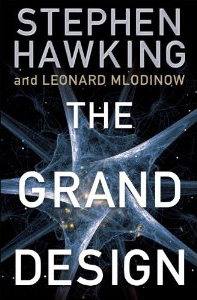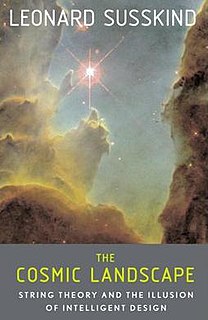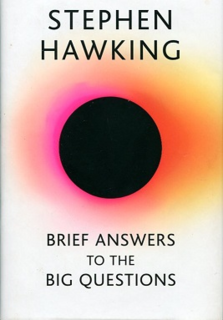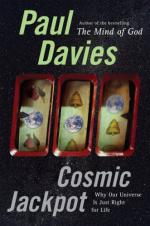
The anthropic principle, also known as the "observation selection effect", is the hypothesis, first proposed in 1957 by Robert Dicke, that there is a restrictive lower bound on how statistically probable our observations of the universe are, because observations could only happen in a universe capable of developing intelligent life. Proponents of the anthropic principle argue that it explains why this universe has the age and the fundamental physical constants necessary to accommodate conscious life, since if either had been different, we would not have been around to make observations. Anthropic reasoning is often used to deal with the notion that the universe seems to be finely tuned for the existence of life.
The multiverse is a hypothetical group of multiple universes. Together, these universes comprise everything that exists: the entirety of space, time, matter, energy, information, and the physical laws and constants that describe them. The different universes within the multiverse are called "parallel universes", "other universes", "alternate universes", or "many worlds".

Max Erik Tegmark is a Swedish-American physicist, cosmologist and machine learning researcher. He is a professor at the Massachusetts Institute of Technology and the president of the Future of Life Institute. He is also a scientific director at the Foundational Questions Institute and a supporter of the effective altruism movement.

Alan Harvey Guth is an American theoretical physicist and cosmologist. Guth has researched elementary particle theory. He is Victor Weisskopf Professor of Physics at the Massachusetts Institute of Technology. Along with Alexei Starobinsky and Andrei Linde, he won the 2014 Kavli Prize "for pioneering the theory of cosmic inflation."

Paul Charles William Davies is an English physicist, writer and broadcaster, a professor in Arizona State University and Director of BEYOND: Center for Fundamental Concepts in Science. He is affiliated with the Institute for Quantum Studies in Chapman University in California. He previously held academic appointments in the University of Cambridge, University College London, University of Newcastle upon Tyne, University of Adelaide and Macquarie University. His research interests are in the fields of cosmology, quantum field theory, and astrobiology.
Goldilocks or "Goldilocks and the Three Bears" is a 19th-century fairy tale.

The characterization of the universe as finely tuned suggests that the occurrence of life in the universe is very sensitive to the values of certain fundamental physical constants and that the observed values are, for some reason, improbable. If the values of any of certain free parameters in contemporary physical theories had differed only slightly from those observed, the evolution of the Universe would have proceeded very differently and life as it is understood may not have been possible.

Leonard Susskind is an American physicist, who is a professor of theoretical physics at Stanford University, and founding director of the Stanford Institute for Theoretical Physics. His research interests include string theory, quantum field theory, quantum statistical mechanics and quantum cosmology. He is a member of the US National Academy of Sciences, and the American Academy of Arts and Sciences, an associate member of the faculty of Canada's Perimeter Institute for Theoretical Physics, and a distinguished professor of the Korea Institute for Advanced Study.

Andrei Dmitriyevich Linde is a Russian-American theoretical physicist and the Harald Trap Friis Professor of Physics at Stanford University.

Laura Mersini-Houghton is an Albanian-American cosmologist and theoretical physicist, and professor at the University of North Carolina at Chapel Hill. She is a proponent of the multiverse hypothesis and the author of a theory for the origin of the universe that holds that our universe is one of many selected by quantum gravitational dynamics of matter and energy. Predictions of her theory have been successfully tested by astrophysical data. She argues that anomalies in the current structure of the universe are best explained as the gravitational tug exerted by other universes.

Sean Michael Carroll is an American theoretical physicist and philosopher who specializes in quantum mechanics, gravity, and cosmology. He is (formerly) a research professor in the Walter Burke Institute for Theoretical Physics in the California Institute of Technology (Caltech) Department of Physics and an External Professor at the Santa Fe Institute. He is currently Homewood Professor of Natural Philosophy at Johns Hopkins University in Baltimore from the summer of 2022. He has been a contributor to the physics blog Cosmic Variance, and has published in scientific journals such as Nature as well as other publications, including The New York Times, Sky & Telescope and New Scientist. He is known for atheism, critique of theism and defense of naturalism. He is considered a prolific public speaker and science populariser. In 2007, Carroll was named NSF Distinguished Lecturer by the National Science Foundation.

The Boltzmann brain thought experiment suggests that it might be more likely for a single brain to spontaneously form in a void rather than for the entire universe to come about in the manner cosmologists think it actually did. Physicists use the Boltzmann brain thought experiment as a reductio ad absurdum argument for evaluating competing scientific theories.
The simulation hypothesis proposes that all of our existence is a simulated reality, such as a computer simulation.

Parallel Worlds: A Journey Through Creation, Higher Dimensions, and the Future of the Cosmos is a popular science book by Michio Kaku first published in 2004.
The Goldilocks principle is named by analogy to the children's story "The Three Bears", in which a young girl named Goldilocks tastes three different bowls of porridge and finds she prefers porridge that is neither too hot nor too cold, but has just the right temperature. The concept of "just the right amount" is easily understood and applied to a wide range of disciplines, including developmental psychology, biology, astronomy, economics and engineering.

The Grand Design is a popular-science book written by physicists Stephen Hawking and Leonard Mlodinow and published by Bantam Books in 2010. The book examines the history of scientific knowledge about the universe and explains eleven-dimensional M-theory. The authors of the book point out that a Unified Field Theory may not exist.

The Cosmic Landscape is a non-fiction popular science book on the anthropic principle and string theory landscape. It is written by theoretical physicist Leonard Susskind. The book was initially published by Little, Brown and Company on December 12, 2005.

a book by Brian Greene published in 2011 which explores the concept of the Multiverse.

Brief Answers to the Big Questions is a popular science book written by physicist Stephen Hawking, and published by Hodder & Stoughton (hardcover) and Bantam Books (paperback) on 16 October 2018. The book examines some of the universe's greatest mysteries, and promotes the view that science is very important in helping to solve problems on planet Earth. The publisher describes the book as "a selection of [Hawking's] most profound, accessible, and timely reflections from his personal archive", and is based on, according to a book reviewer, "half a million or so words" from his essays, lectures and keynote speeches.

Is There a God? is a 1996 book by British philosopher of religion Richard Swinburne, claiming the existence of the Abrahamic God. The argument rests on an updated version of natural theology with biological evolution and Big Bang theory using scientific inference. In 2010, a revised version of the original book was released under the same title.















